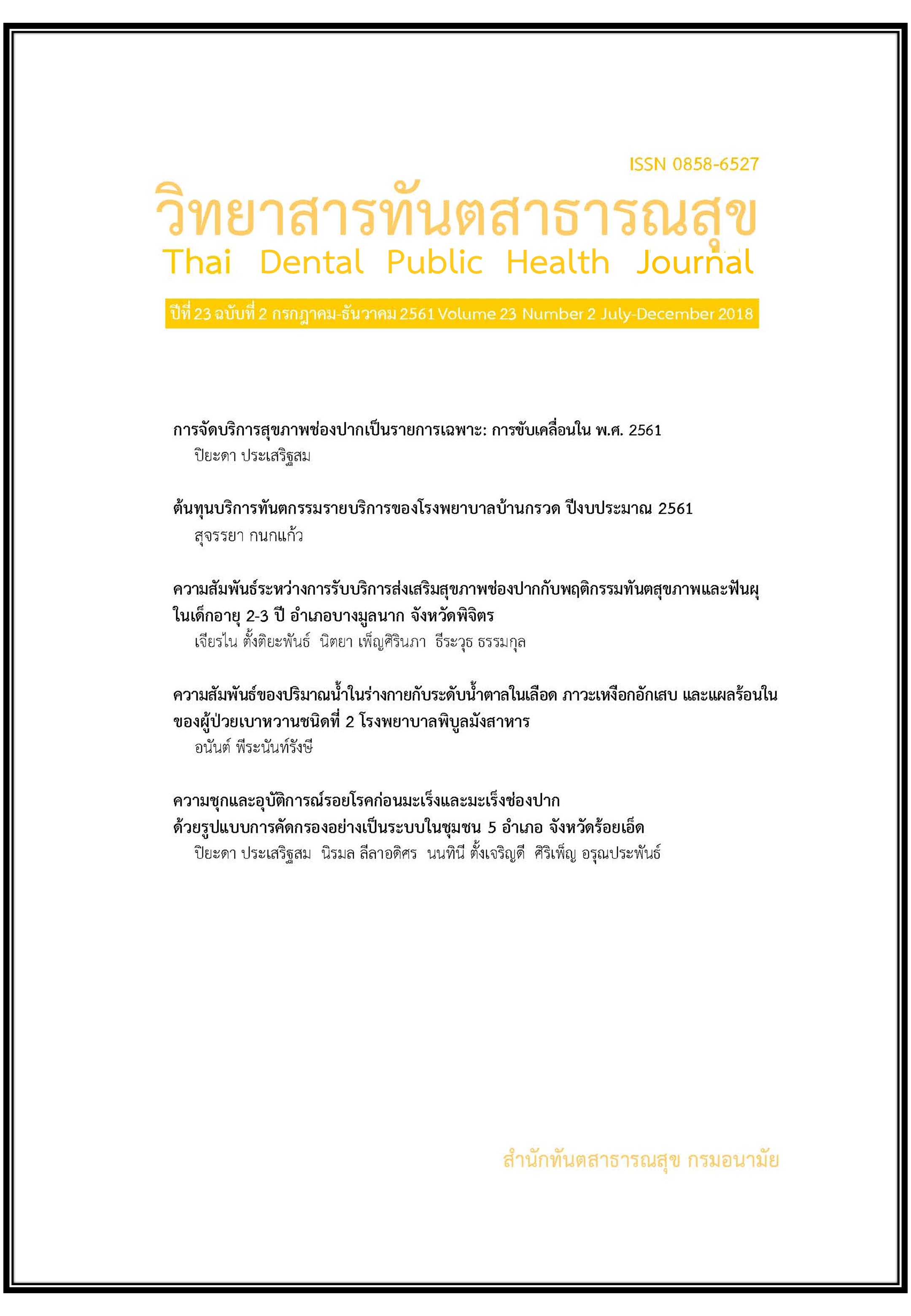ความสัมพันธ์ระหว่างการรับบริการส่งเสริมสุขภาพช่องปากกับพฤติกรรมทันตสุขภาพและฟันผุในเด็กอายุ 2-3 ปี อำเภอบางมูลนาก จังหวัดพิจิตร
Main Article Content
บทคัดย่อ
การวิจัยเชิงพรรณนานี้มีวัตถุประสงค์เพื่อศึกษาความสัมพันธ์ระหว่างการรับบริการส่งเสริมสุขภาพช่องปาก ของผู้ปกครองและเด็กกับพฤติกรรมทันตสุขภาพและฟันผุของเด็กอายุ 2-3 ปีในศูนย์พัฒนาเด็กเล็ก 8 แห่งของอำเภอบางมูลนาก จังหวัดพิจิตร กลุ่มตัวอย่างคือเด็ก 222 คนและผู้ปกครอง โดยสุ่มอย่างง่ายจากประชากรเด็ก 612 คนในศูนย์พัฒนาเด็กเล็ก 8 แห่ง เก็บข้อมูลระหว่าง 20 กันยายนถึง 20 ตุลาคม พ.ศ. 2561 โดยใช้แบบตรวจสภาวะและความสะอาดฟันของเด็ก และแบบสอบถามโดยผู้ปกครองเขียนตอบเองซึ่งประกอบด้วยข้อมูลทั่วไปของผู้ปกครองและเด็ก และพฤติกรรมการดูแลการบริโภคของเด็กและการแปรงฟันให้เด็ก วิเคราะห์ข้อมูลด้วยสถิติพรรณนาและ ไคสแควร์
เด็กกลุ่มนี้มีฟันผุร้อยละ 37.4 และร้อยละ 14.4 มีฟันผุมากกว่า 4 ซี่ มีรอยขุ่นขาวที่ฟันร้อยละ 46.8 และร้อยละ 23.0 มีแผ่นคราบจุลินทรีย์ที่ฟันหน้าบน 4 ซี่ ด้านพฤติกรรม การแปรงฟันให้เด็กอยู่ในระดับดีร้อยละ 71.2 ส่วนการบริโภคของเด็กส่วนใหญ่อยู่ในระดับปานกลางร้อยละ 51.4 การได้รับบริการส่งเสริมสุขภาพช่องปากของผู้ปกครองสัมพันธ์กับการแปรงฟันก่อนนอนให้เด็กอย่างมีนัยสำคัญทางสถิติ (p=0.033) และการแปรงฟันให้เด็กสัมพันธ์กับฟันไม่ผุอย่างมีนัยสำคัญทางสถิติ (p=0.002) แต่ไม่พบความสัมพันธ์ระหว่างการได้รับบริการส่งเสริมสุขภาพช่องปากของทั้งผู้ปกครองและเด็กกับฟันผุ
Downloads
Article Details
เอกสารอ้างอิง
2. Dental department. Oral health survey. Phichit: Bang Mun Nak hospital, 2017. [on line] 7 Jun 2018 [cited 2018 Jun 9]; Available from : URL:https://www.bmnhos.com/en/internal/ ทันตกรรม/service-profile.html (in Thai)
3. Bureau of Dental Health. The 8th National oral health survey report, 2017. [cited 2018 Jun 6]; Available from : URL:https://dental2.anamai. moph.go.th/ewt_dl_link.php?nid=2423 (in Thai)
4. Zafar S, Harnekar SY, Siddiqi A. Early child-hood caries: etiology clinical considerations, consequences and management. International dentistry South Africa 2009; 11(4): 24-36.
5. Larpparisutthi P. Tooth decay in children. Mahachakri Sirindhorn dental hospital: Golden Jubilee Medical Center Conference; 2015. (in Thai)
6. Sukanwaranil S. Phomma S. Dental caries status and the risk factors of children 1-24 months old.Thailand Journal of Dental Public Health 2014; 19(1): 66-75. (in Thai)
7. Sutawa K. Evaluation of oral health promotion and dental caries prevention in well child clinic, Erawan district, Loei province, during 2010-2013. Thailand Journal of Dental Public Health 2015; 20(1): 43-7. (in Thai)
8. Rueang-ngam P. Factor related to dental caries of preschool children at day care centers in Khanuworaluksaburi district, Kamphaeng Phet province. Thailand Journal of Dental
Public Health 2013; 18(2): 9-19. (in Thai)
9. Weintraub JA, Romos- Gomez F, Jue B, Shain S, Hoover CI, Featherstone JDB. Fluoride varnish efficacy in preventing early childhood caries. Journal of dental research 2006; 85(2): 172-6.
10. American academy of pediatric dentistry. Guideline on caries-risk assessment and management for infants, children and ado-lescents 2014; 38(6): 142-9.
11. Boonsuya C. Population, sample selection and sample size in research. in Statistics and research in health management. 4th ed. Nonthaburi: Sukhothai Thammathirat university press; 2016. p. 8-59. (in Thai)
12. World Health Organization. Oral health surveys: basic methods. 5th ed., 2013. [cited 2018 Jun 6]; Available from : URL: https://apps.who.int/iris/bitstream/handle/10665/97035/9789241548649_eng.pdf;jsessionid=B0F0B520C82471F9DB22F0ECC3D79C09?sequence=1
13. Best JW, Kanh JV. Research in education. 8th eds. United States of America: A Viacom company; 1998. p. 335-423.
14. Khrueasan S. The comparison of oral healthcare behaviors and dental health status among preschool children’s parents with and without continuous visiting well child dental clinic, Lomsak hospital, Phetchabun province. Thai Dental Nurse Journal 2017; 28(2): 47-57. (in Thai)
15. Chanchorn W. Comparison result of oral health promotion programme for the 2 month-old and 6 month-old children until they reached 18 months at well child clinic, Song hospital, Phrae province. Thailand Journal of Dental Public Health 2016; 21(1): 34-9. (in Thai)


